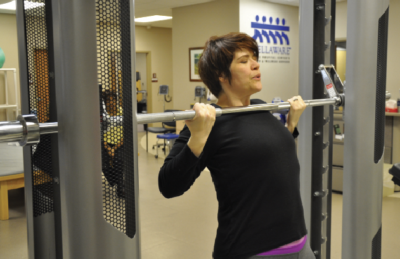
Get Strong, Stay Strong
By Jessica Park
The words women and weightlifting may make you picture female professional bodybuilders posing in a competition. But muscles are made for more than flexing; you literally couldn’t get out of bed without them. Our muscles help us do so much that it’s easy to take them for granted.
But, with age, our bodies lose muscle naturally, gradually making even everyday activities more difficult. Because women typically have less lean mass than men, we’re more susceptible to losing strength. Unfortunately, women are also less inclined to do strength training.
Whether you call it weightlifting, strength training or toning, building and keeping muscle is an important part of a healthy lifestyle. We talked to Boone Hospital WELLAWARE fitness instructors Heidi Salter and Nicky Zimmermann to learn more about the benefits and basics.
According to fitness instructor Nicky Zimmermann with Boone Hospital’s WELLAWARE fitness center, getting strong now keeps you strong later: “In our 30s, we begin losing muscle as we age, a process called sarcopenia,” she says. “And after menopause, women lose more muscle mass and bone density.”
Weight-bearing exercise increases lean mass and bone density, lowering your osteoporosis risk or preventing fractures if you have osteoporosis.
Strength training improves your whole body. It can reduce body fat and increase metabolism; improve flexibility, range of motion, posture and balance; lower high blood pressure and improve blood glucose levels in type II diabetes patients. Strengthening your body may relieve or reduce pain, prevent injury or help correct postural alignment.
It’s also good for your mental health; regular exercise alleviates anxiety and depression, and making progress can boost your confidence and self-esteem.
The benefits go beyond the weight room. Being stronger makes it easier to carry groceries, pick up your children, work in your garden, change a flat tire or open a new jar of pickles. If you run, adding a strength training regimen can help you beat your personal record on your next 5K.
Don’t worry about “bulking up.” Zimmermann explains that most women have too much estrogen to increase their muscle size like men. Lower testosterone also causes women to build muscle differently and more slowly. Increased lean mass, however, can make you look trim; five pounds of muscle occupy less space than five pounds of fat.
You can find strength training exercises that fit your abilities, goals and lifestyle, including bodyweight exercises, resistance bands, exercise machines and free weights.
First, talk to your physician before starting a new exercise program, especially if you have health conditions, injuries, joint pain, have recently had surgery, are pregnant, or have started or changed medications.
Salter recommends beginners strength train two or three days a week, taking at least a full day off in between.
If you’re unsure how to begin, an exercise professional can help. The WELLAWARE fitness center provides one-on-one orientation sessions for all new members, to assess your current fitness level, introduce you to the equipment, and discuss what you want to get out of an exercise program. WELLAWARE also offers personal training sessions to help you master proper form and technique and plan workouts to achieve your fitness goals.
After six months, you can challenge yourself and add an extra day or two of strength training. (Most people who train this frequently do split routines, alternating upper and lower body workouts.)
Start with one or two sets of eight to 12 reps of an exercise, using a weight you can lift at least eight reps in correct form. As you adjust, you can progress to three sets. Rest 30 to 90 seconds between sets. If you can do more than 15 reps in proper form, increase the weight or resistance level.
Work your whole body. Salter recommends becoming familiar with the normal ranges of motion in major areas, like your legs, hip flexors and extensors, back, chest, arms and shoulder. Work the major groups first. Be sure to work both sides of your body and opposing muscle groups; if you work your biceps, don’t forget your triceps.
Use slow and controlled movements in both directions the way up and the way down. Exhale during concentric moves, when the muscle is shortened (such as the lifting part of a bicep curl), and inhale during eccentric, or lengthening, moves.
According to Salter and Zimmermann, in strength training, quality beats quantity — it’s better to lift less weights or do fewer reps in proper form. Proper form improves the effectiveness of an exercise and reduces risk of injury. Use a mirror or ask a friend to check your form.
Don’t overdo it. If anything hurts, stop. While soreness a day or two after working out is common, you shouldn’t be in pain during your workout. And don’t strength train every day; take a day or two off in between sessions. Rest days and adequate sleep give your body the time necessary to recover between workouts.
Just as strength training workouts improve your whole body, taking care of your whole body improves your workouts. Stay hydrated before, during and after workouts, and eat adequate protein to repair and grow muscle cells. (Learn how to get more protein in your diet on page 21.)
Be consistent, but mix up your routine. As your body adjusts to the challenges, Salter recommends periodically changing exercises, order or intensity. Try something new, like kettlebells, medicine balls or weighted hoops. Stay motivated by setting new, specific goals. Track your progress in a notebook or app.
Finally, don’t fixate on the scale or mirror to measure progress. Our fitness instructors say that intrinsic rewards, like more confidence and self-esteem are what really help you stick with a workout program.
Zimmermann adds: “If you don’t enjoy it, you won’t do it.”